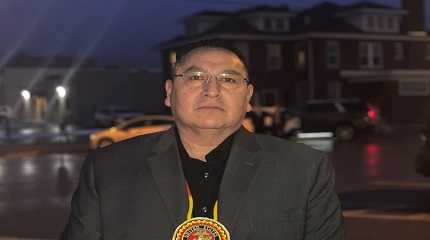
South Dakota. (AP) —The leader of a South Dakota tribe is expected to declare an emergency on the state’s largest Native American reservation because of rampant crime that he said hasn’t been curbed due to the U.S. government’s inadequate funding for law enforcement.
The state of emergency declaration planned for Saturday on the Pine Ridge Indian Reservation comes nearly six months after a federal judge ruled the U.S. government has a treaty obligation to support law enforcement on the reservation, but declined to determine whether the Oglala Sioux Tribe is entitled to the full funding amount requested.
Oglala Sioux President Frank Star Comes Out said in an interview Friday that conditions on the reservation have worsened since the ruling, prompting him to sign the emergency proclamation.
The U.S. government and its agencies — namely the Interior Department and the Bureau of Indian Affairs — are primarily responsible for the breakdown of law and order on the reservation and negotiations between the government and the tribe are not progressing, Star Comes Out said.
“I feel they’re stalling,” he said.
A draft of the proclamation obtained by The Associated Press said the U.S. government has failed “to fulfill the United States’ treaty, statutory and trust responsibilities to provide adequate law enforcement on the Reservation.”
Gun violence, drug offenses and rapes have become increasingly common on the Pine Ridge reservation. Only 33 officers and eight criminal investigators are responsible for more than 100,000 emergency calls each year across the 5,400-square-mile (14,000-square-kilometer) reservation, tribal officials have said.
The reservation is roughly the size of Connecticut, while the population size is a subject of dispute.
Oglala Sioux officials contend the tribe is entitled to federal funding for 120 fully equipped officers for the reservation, something the federal government has disputed.
Ben Fenner, an attorney for the tribe, said the current staffing equates to four or five officers per shift at any given time.
U.S. District Judge Roberto Lange told the federal government in May to reevaluate its census-based population estimates for the reservation of 19,800 to 32,000, which are lower than the tribe’s figure of 40,000. The judge said the federal estimates likely represent an undercount.
Star Comes Out said police response times on the reservation take hours, if they respond at all.
“With five police officers, it’s just impossible,” he said. “Our officers are overworked, underpaid. They’re outmanned. And it’s dangerous for them to respond to calls by themselves.”
When asked for a response to the tribe’s expected declaration, the Bureau of Indian Affairs said in an email that it does not comment on ongoing litigation.
Giovanni Rocco, a spokesperson for the Interior Department, noted in an email to the AP that the department’s Law Enforcement Task Force has recommended the federal government increase law enforcement staffing levels on reservations.
Robert Miller, a law professor at Arizona State University with expertise in federal Native American law, said the tribe’s proclamation does not have any legal impact. However, it raises attention to the issue and puts pressure on the U.S. government.
“The tribe is litigating a serious life and death matter and alleging that the United States has violated both its trust responsibility and treaty response to help protect the Oglala Sioux people,” said Miller, an enrolled citizen of the Eastern Shawnee Tribe in Oklahoma.
“Can the tribe force the United States to pay more money to fund needed tribal services? Every tribal nation faces issues like this,” he said.
Miller said the case is far from over.
Tribal leaders depicted the ruling as a victory in May, saying the important point is the court confirmed the federal government has a duty to fund policing on the reservation and ordered U.S. officials to meet with Oglala Sioux leaders “to work together promptly to figure out how to more fairly fund tribal law enforcement.”
The case’s outcome could affect other reservations, including some where Native women are killed at a rate more than 10 times the national average. The Northern Cheyenne Tribe in Montana filed a similar lawsuit.
Lange, the judge in the Oglala Sioux case, has noted the Pine Ridge reservation is among the most impoverished places in the country.
“In recent years, communities on the Reservation have struggled with dangerous and highly addictive drugs and experienced unprecedented levels of violence and threats to public safety,” he wrote. “In the Tribe’s view, a lack of competent and effective law enforcement on the Reservation is a big reason for the crisis.”
While neither side disputes crime is very high on the reservation and its police are underfunded, the judge wrote, the federal government insists “the funding is fair given budget constraints and Congress’s decision to underfund law enforcement services in Indian country generally.”




